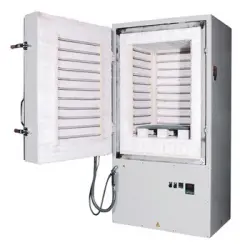Advanced Materials Furnaces & Kilns
“Advanced materials” is a broad term for materials that have properties superior to more traditional or conventional materials such as hardness, durability, elasticity, resistance to chemicals, bio-activity, electrical characteristics and molecular qualities. Materials are typically broken down into groups like metals, polymers, ceramic, composites and glasses. Some advanced materials like carbon fiber in composites or bio ceramics are already well known and used in products, and others will take a few more years to be commercialized. Emerging technologies like energy generation and storage will drive further demand for new materials.
Ceramic materials are classified according to their chemical or mineralogical composition. They mainly consist of combinations of Oxides, Silicates, Carbides, Nitrides and Borides or graphite. Ceramic materials are classified according to IEC 672 but could also be grouped into functional or construction ceramics. The oldest ceramic is the silicate ceramic. Today, aluminum oxides (alumina) are the workhorses of advanced materials. Other well-known, advanced technical ceramics are Zirconium Oxides, fused silica, titanium diboride, boron carbide, silicon carbide, aluminum nitride, boron nitride and silicon nitride.
While carbon fiber as an advanced engineering material is already well known, current research is quickly expanding our understanding of its capabilities. There has been a great amount of progress in the processing and manipulation of carbon materials on atomic and molecular levels to create a large variety of unique and valuable properties. Diamond films, superconductive materials, Ceramic Matrix Compounds (CMC) and nano-scale arrangements (example: carbon nano-fiber) of carbon are being found to hold solutions to some of today’s toughest problems.
Some of the many process challenges Keith’s laboratory furnaces and atmosphere furnaces successfully solve are homogeneous temperatures to 1800°C, integral drying and firing of saturated materials, uniform heat treatments of dense material, low tolerance for impurities, high volume organic volatilization and venting, process repeatability and resistance to chemical attack.
Many of these new materials are produced in small, high temperature box furnaces or bottom loading furnaces with up to 1800°C and Keith Company serves that market.
Many of our customers need greater production capacities, which lead them to invest in envelope kilns, shuttle kilns, or pusher kilns. The cost of a single load of the material to be processed can exceed one million dollars, so special attention needs to be paid to reliability and accuracy of the equipment to control and monitor temperature profile, atmosphere, exhaust system and auxiliary equipment such as specialty gas atmosphere controls, thermal oxidizers, scrubbers and filters. Keith has equipment designs and capabilities to meet these needs as well.
Furnace types:
- Front loading furnace
- Bottom loading furnace
- Pusher Kilns
- Envelope / Shuttle Kilns
- Atmosphere furnaces
Contact Keith Company to order a laboratory furnace or box furnace for your advanced materials processing, or to learn more about any of our products.






